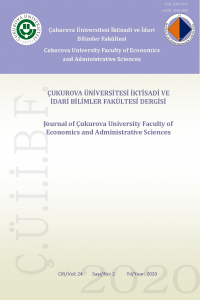Türkiye’nin Fasıllara Göre İthalat Talep Fonksiyonunun Ekonometrik Tahmini
İthalat Fonksiyonu, Eş Bütünleşme, ARDL, Johansen Maksimum Olabilirlik Yöntemi
Econometric Estimation of Sectoral Import Demand Function of Turkey
Import Function, Cointegration, ARDL, Johansen Maximum Likelihood Methods,
___
- AKTAŞ, C. ve Güven, D. (2003). Gümrük Birliği Sonrasında Türkiye’nin İthalat Fonksiyonu Katsayılarındaki Değişimin İncelenmesi, Dumlupınar Üniversitesi Sosyal Bilimler Dergisi, 9, 67‐80.
- BAYRAKTUTAN, Y. ve Bıdırdı, H. (2010). Türkiye İthalatının Temel Belirleyicileri Ege Akademik Bakış, 10 (1) 2010, 351-369.
- COLLIER, P. & Goderis, B. (2009). Commodity Prices, Growth, and the Natural Resource Curse: Reconciling a Conundrum OxCarre Working Papers 014.
- DAVIS, J.H. & Irwin, D.A. (2007). "The Antebellum U.S. Iron Industry: Domestic Production and Foreign Competition," NBER Working Papers13451, National Bureau of Economic Research, Inc.
- DOĞANLAR, M., Bal, H. ve Özmen, M. (2006) Türkiye ile Almanya Arasındaki Dış Ticaretin Ekonometrik Analizi ve Gümrük Birliği Sonrası Karşılaştırma İktisat İşletme ve Finans Dergisi, Yıl:21, 50-65.
- FAN, C.S. & Hu, Y. (2008). Imports of capital goods and enterprise performance: a firm-level analysis in China, Applied Economics Letters, 15:5, 391-394.
- HASAN, R. (2002). The impact of imported and domestic technology on the productivity of firms: Panel data evidence from Indian manufacturing firms. Journal of Development Economics, 69, 23–49.
- KOÇAK, F. İ., (2011) Türkiye’nin İthalat Fonksiyonunun Ekonometrik Tahmini, Çukurova Üniversitesi Sosyal Bilimler Enstitüsü Yüksek Lisans Tezi.
- LANDON, S. & Smith, C.E. (2007). The exchange rate and machinery and equipment imports: Identifying the impact of import source and export destination country currency valuation changes , The North American Journal of Economics and Finance, Volume 18, Issue 1, 1 February 2007, Pages3-21.
- MAZUMDAR, J. (2001). Imported machinery and growth in LDCs, Journal of Development Economics, 65 (1) (2001), pp. 209–224.
- MENON, J. (1993). Exchange Rate Pass-Through: Australian Imports of Motor Vehicles, International Economic Journal, 7:3, 93-109.
- MODY, A., & Yilmaz, K. (2002). Imported machinery for export competitiveness. The World Bank Economic Review, 16(1), 23–48.
- PESARAN, M. H., Shin, Y. & Smith, R. J. (2001). Bounds Testing Approaches To The Analysis Of Level Relationships Journal of Applied Econometrics, 16:, 289-326. www.tcmb.gov.tr www.tuik.gov.tr
- ISSN: 1300-3747
- Başlangıç: 1987
- Yayıncı: Çukurova Üniversitesi
TMS11 - İnşaat Sözleşmeleri Standardına Göre Tamamlanma Yüzdesi Yöntemi
Ankara İli Özel Hastanelerinin Veri Zarflama Analizi ile Etkinlik Ölçümü
Ediz ATMACA, Fatih TURAN, Gözde KARTAL, Emine Sinem ÇİĞDEM
Türkiye’nin İthalat Fonksiyonunun Ekonometrik Tahmini
Manavgat Bölgesindeki Konaklama İşletmelerine Yönelik e-Şikayetlerin İçerik Analizi
E.köksal SEZGİN, Seyran EFİLTİ, M.bahadır KALIPÇI, Seden ALGÜR
Reel Döviz Kuru ve Ticaret Dengesi: Türkiye’nin Almanya ile Ticareti Örneği (2002.01-2012.09)
Tüketici ve Üretici Fiyat Endekslerinde Fiyat Geçişkenliği: Alt Sektörler
İşletmelerde Performans Ölçüm Modelleri
Özlem Yalaz SEÇİM, Özer ALPAR, Seden ALGÜR
Türkiye’nin Fasıllara Göre İthalat Talep Fonksiyonunun Ekonometrik Tahmini
